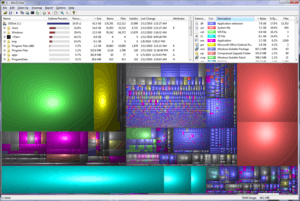WinDirStat
WinDirStat is a free and open-source graphical disk usage analyzer for Microsoft Windows. It is notable for presenting a sub-tree view with disk use percentage alongside a usage-sorted list of file extensions that is interactively integrated with a colorful graphical display (a treemap).[1][2][3] Created as an open source project released under the GNU GPL, it was developed using Visual C++/MFC 7.0 and distributed using Sourceforge. The project was inspired by KDirStat, a KDE application for Unix-like operating systems.[4][5]
 | |
 WinDirStat 1.1.2 | |
| Developer(s) | Bernhard Seifert and Oliver Schneider |
|---|---|
| Initial release | 1 October 2003 |
| Stable release | 1.1.2
/ 2 September 2007 |
| Repository | |
| Operating system | Windows |
| Platform | IA-32 |
| Size | 0.6 MB |
| Type | Disk space analyzer |
| License | GNU GPLv2 |
| Website | windirstat |
Popularity
WinDirStat has been downloaded more than 9.2 million times from the official source since the original release in October 2003.[6] As of July 2014, it is the second most downloaded "Filesystems" software on SourceForge with over 13,000 downloads per week.[7] The tool is still up to date and its usage is designed for all platforms.
Project status
The most recent release was in September 2007 and development stopped for some time after that. However, the project's blog noted that development resumed in May 2009 and some updates to the code were added in 2016.[8]
Source code
Source code is provided for all released versions on the SourceForge page in ZIP format.
WinDirStat is developed via Mercurial revision control.
Features
- List of detected file extensions, and the percentage of space each file extension takes up.
- Each extension has its own color on the graphical map.
- Is able to scan internal, external and networked drives.
- Portable version besides the installer
- User-created clean up jobs
- Send report via email
Version history
| Version | Date | Information |
|---|---|---|
| 1.1.2 (#2) | September 2007 | Added translations: Finnish, Dutch, Russian, Estonian |
| 1.1.2 (#1) | September 2006 | Spanish, Hungarian, Italian, and Czech translations. Minor optimization |
| 1.1.1 | January 2005 | "Christmas Release" Pacman replaces progress bar, Polish translation, localization tweaks, documentation updates, bugfixes |
| 1.1.0 | January 2004 | Added French translation, feature tweaks, bugfixes |
| 1.0.1 | December 2003 | Bugfixes, added more display columns, added drive selection dialog |
| 1.0.0 | October 2003 | First release. 1.0.0 README states: Design and many details are based on KDirStat (kdirstat.sourceforge.net). WinDirStat is "a KDirStat re-programmed for MS Windows". |
Media reception
FossHub (official download mirror of WinDirStat) reported 6,912,000 in January 2019, being the most downloaded software from "Disk Analysers" category."[9]
Steve Bass of PC World provided a brief review of the 1.1.2 release of WinDirStat, summarizing its usefulness: "Windirstat is [a] colorful and nifty tool to check the makeup of your hard drive -- especially if you're looking for immense files. It scans your drive and produces a treemap that shows each file as a colored rectangle that's proportional to the file's size..."[10]
In 2006, WinDirStat was "Download of the day" on Lifehacker. Reviewer Adam Pash praised WinDirStat for its ability to easily clean up unnecessary files, by stating: "If you find a large file or two taking up loads of space that you had forgotten was there and don't need, it's easy to clean up directly from WinDirStat. "
CNET reviewed the most recent release of WinDirStat and gave it 5 of 5 stars. It called WinDirStat a "great piece of freeware" and noted: "It's one of those tools that you didn't know you needed until you started using it, but once installed, it's hard to imagine life without it..."[11]
Gizmo's Freeware directory featured WinDirStat in a January 2010 list of best free disk analysis software with a 4 of 5 stars review, noting: "The open source program WinDirStat is [an] outstanding program. It uses three ways to display the disk usage: a directory list, a file extension list and a rectangular treemap. The visual presentation, overall usability and scan speed makes this a great tool to visualize disk usage."[12]
The German computer magazine c't (magazin für computertechnik) published a review of WinDirStat with it bundled in a CD in October 2006.[13]
In 2011, Jack Wallen from TechRepublic called WinDirStat: "one of those simple little apps you are going to be very thankful you have when you need it." He also highlighted its usability: "If space is an issue (...) you will see just how much time this tool can save you." However, Jack Wallen criticized the documentation, stating: "The biggest issue with WinDirStat is the documentation. The minute you try to create your own user-configured cleanup routines you will quickly experience a complete lack of documentation, which makes the task rather challenging, if not impossible."[14]
Derived Programs
Because WinDirStat is open source, other programs have been created based on WinDirStat. A popular version called AltWinDirStat was started in 2015. This software removes some features (such as multiple language support) from the original, but features massively faster speed. Development is ongoing.
References
- Yegulalp, Serdar (2010-03-10). "Top free troubleshooting tools for Windows". BusinessWeek. Archived from the original on 2010-03-23.
- "Disk Space Analyzer: WinDirStat". Maximum PC: PC Fix-It Guide. Future US: 56. Summer 2007. ISSN 1522-4279.
- Immler, Christian (2005). Windows XP Professional. Franzis. p. 247. ISBN 978-3-7723-7206-3.
- Bernhard. "Background and history". WinDirStat website. Retrieved 1 Apr 2015.
- "KDirStat". Retrieved 1 Apr 2015.
- "Browse WinDirStat: Windows Directory Statistics". SourceForge. Retrieved 2011-10-11.
- "Filesystems software sorted by popularity".
- "Will resume development now". WinDirStat Blog. 2009-05-30. Retrieved 2010-03-10.
- "Download WinDirStat - FossHub". WinDirStat FossHub page. 2019-01-12. Retrieved 2019-01-12.
- Bass, Steve. "Editorial Review of Windirstat". PC World. Archived from the original on 2012-07-04. Retrieved 2010-03-09.
- "WinDirStat 1.1.2: CNET editors' review". CNET. Retrieved 2010-03-09.
- "Best Free Disk Analyzer". Gizmo's Freeware. 2010-01-21. Retrieved 2010-03-09.
- "WDS featured in c't". WinDirStat weblog. 2006-10-06. Retrieved 2010-03-11.
- "Review: WinDirStat disk usage cleanup tool". 1 February 2011. Retrieved 19 July 2014.